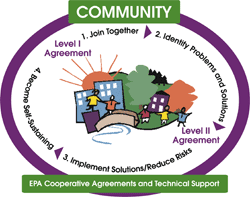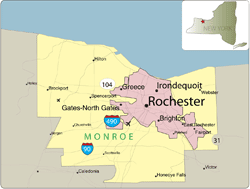Community Action for a Renewed Environment (CARE)
Rochester CARE Collaborative
Fall 2007

About CARE
Community Action for a Renewed Environment (CARE) is an EPA technical assistance and grant program that offers an innovative way for a community to organize and take action to reduce toxic pollution in the local environment.
Level I, Level II Grants
Awarded at two monetary levels, over two years, CARE grants help communities tackle their problems using a four-step process (diagram below). Level I grants (up to $100,000) enable communities to progress through the first two steps, which are: 1) build a broad-based partnership, and 2) identify a range of environmental problems and solutions. Level II grants (up to $300,000) fund the next two steps, which are: 3) take action to reduce risks; and 4) become self-sustaining.
Rochester, the third-largest city in New York state located on the southern shore of Lake Ontario, is home to nearly 220,000 residents who live among businesses and industrial facilities. Rochester is ranked as having the highest risks posed to humans in the Northeast, according to EPA’s Risk Screening Environmental Indicators. This is a method of assigning risk to geographic areas by considering the number of people exposed and affected by the amount and toxicity of its current and past pollution.
The Rochester CARE Collaborative convened a number of local organizations concerned about the city’s environment and provided facilitation services and funding to help the organizations work together and leverage their assets. Today, with more than 30 partners, the Rochester CARE Collaborative is implementing six “mini-projects” to reduce exposure to environmental pollutants.

Step 1: Joining Together
The city has a rich history of community involvement in environmental health issues. Through its Environmental Justice and Children’s Health Initiative, EPA Region 2 had worked with some of the city’s organizations advocating greater environmental health protection. In the summer of 2004, 62 individuals, representing some of those groups, attended the initial meeting to form the Collaborative, and agreed that the local Center for Environmental Information should be the applicant for the inaugural CARE Level I grant.
Step 2: Identifying Problems, Solutions
The Collaborative’s members went through a facilitated process of prioritizing Rochester’s environmental problems. Ranking highest were pollution from lead and stationary and mobile emission sources, and the lack of knowledge about toxics in urban neighborhoods. The Collaborative chose six mini-projects to address aspects of these pollution problems.

This artwork by an elementary school student at Henry Lomb School of Rochester City School District won a CARE-sponsored design competition to create educational messages about air pollution and will be displayed on retrofitted diesel refrigeration trucks.
Step 3: Implementing Solutions, Reducing Risks
Six mini-projects are being implemented under the Rochester work plan:
- A neighborhood toxic education program for residents has distributed nearly 800 educational brochures on making homes safer from pollutants, such as mold and asthma triggers.
- To address children’s health, exhaust from seven school food delivery trucks was tested for pollutants. All seven refrigerated trucks will be equipped with diesel oxidation catalysts to help reduce harmful diesel emissions from idling trucks on school grounds.
- The All Stationary Air Toxics Reduction Project identified the printing sector as a candidate to reduce the emission of hazardous air pollutants through pollution prevention. A workshop for printers was held and, to date, two printers have agreed to develop baseline emission data and implement pollution prevention measures to reduce toxic emissions.
- The Lead Remediation Project successfully introduced property owners (owner-occupied and investor owners) to workshops sponsored by EPA/US Department of Housing and Urban Development on lead-safe work practices. These workshops are conducted free of charge by several local nonprofit organizations.
- Representatives from several school districts attended a presentation given by a CARE Collaborative partner on reducing toxic pollutants from motor vehicles idling at schools. In addition, 180 people who manage motor fleets attended a workshop on alternative fuels.
- The Collaborative is developing a conservation Web site to inform the public about energy and water conservation methods, the benefits of reduced pesticide use, and ways to reduce mercury exposure.

Rochester, NY
Step 4: Becoming Self-Sustaining
A measure of Rochester CARE Collaborative’s sustainability is that the number of partners is growing even as the Collaborative works to complete its projects. The Collaborative’s members have committed to continue meeting and have secured funding beyond September 30, 2007, when CARE funds expire. One sponsor contributed $10,000-15,000 to develop a conservation Web site.
In addition, the Collaborative secured an EPA Environmental Justice Collaborative Problem-Solving grant to extend and expand its toxics education program over the next three years. One project funded through the new grant will be a strategy to identify organizations that can work with the construction industry to reduce toxic air pollution from construction equipment.
Partners
- American Lung Association
- Bausch and Lomb, Inc.
- City of Rochester
- Eastman Kodak Company
- Federation of Monroe County Environmentalists
- Genesee Transportation Council
- Monroe County Health Department NeighborWorks Rochester
- New York State Department of Environmental Conservation
- University of Rochester
- U.S. EPA Region 2
For Further Information
Please visit the CARE Web site for more information.
Derval Thomas (Thomas.Derval@epa.gov), Region 2 Project Lead
U.S. EPA, Region 2
(212) 637-4028
Margit Brazda Poirier, CARE Project Lead
Center for Environmental Information
(585) 262-2870
www.CEInfo.org ![]()
PDF Versions
- Rochester CARE Collaborative, Fall 2007 (PDF) (2 pp, 271K, About PDF)
